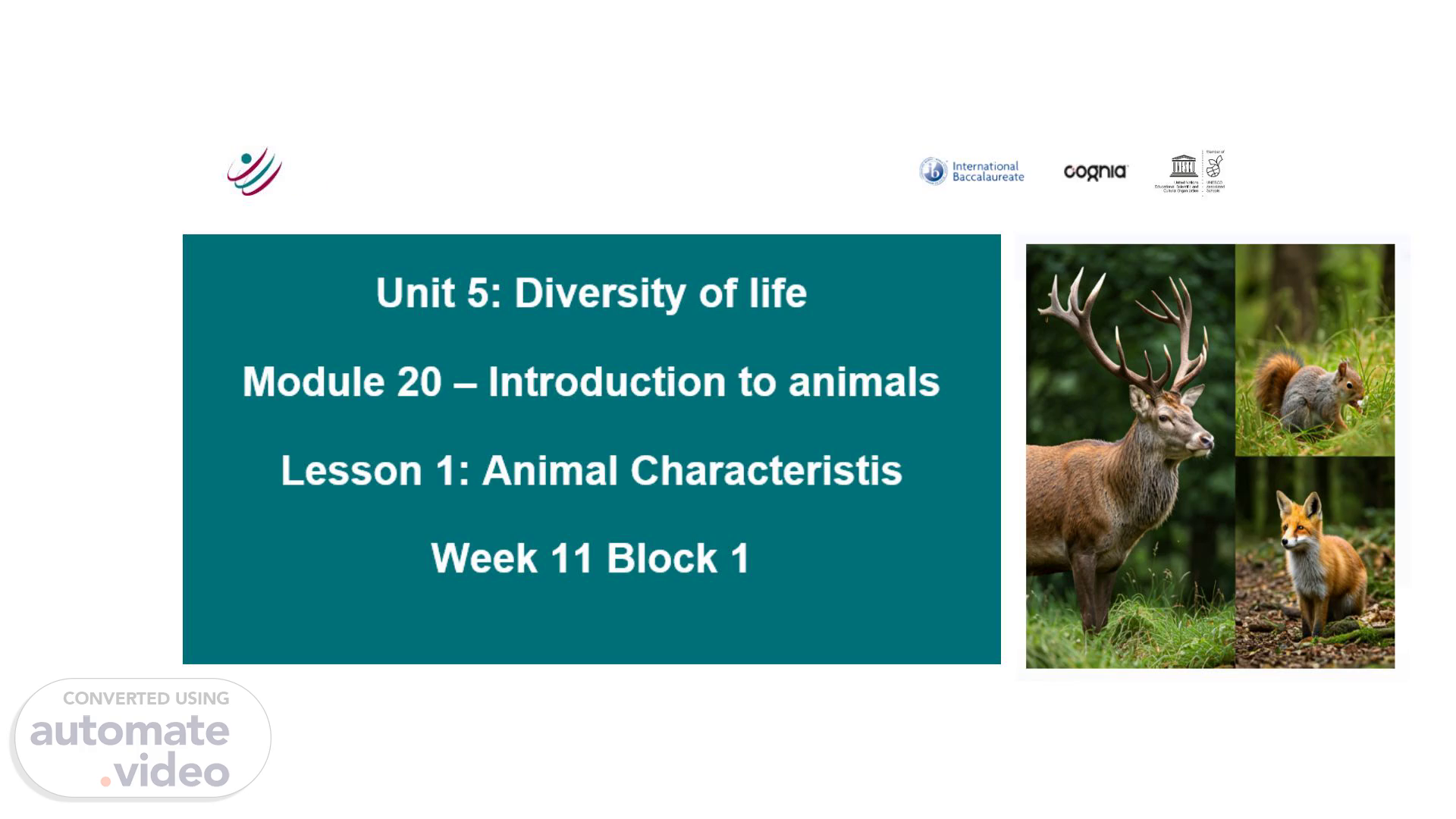
Unit 5: Diversity of life Module 20 – Introduction to animals Lesson 1: Animal Characteristis Week 11 Block 1
Scene 1 (0s)
Unit 5: Diversity of life Module 20 – Introduction to animals Lesson 1: Animal Characteristis Week 11 Block 1.
Scene 2 (12s)
Title. Key Concept / Related Concepts: Relationships, Form, Function, Diversity Global Context: Scientific and Technical Innovation Exploring how the structure and function of animals support survival and adaptation. Statement of Inquiry: The structure and diversity of animals reflect their ability to interact with and adapt to their environment, supporting survival and biodiversity. Inquiry Questions: Factual: Focus on basic knowledge Conceptual: Explore relationships and processes Debatable: These questions provoke critical thinking, encouraging students to explore perspectives and take a position..
Scene 3 (39s)
Title. Learning Targets. Criterion A: Knowing and Understanding I can identify and describe the main characteristics of animals, such as symmetry, movement, and multicellularity. I can compare animals to other life forms based on their structure and function. Criterion B: Inquiring and Designing I can explore how animals adapt to different environments to support survival and biodiversity. I can classify animals by applying scientific criteria, such as body symmetry and the presence of a backbone..
Scene 4 (1m 1s)
Title. Learning Targets. Criterion C: Processing and Evaluating I can analyze how the structure of animals supports their ecological roles and interactions within an ecosystem. I can assess the relationship between form and function in animals and explain its significance for adaptation. Criterion D: Reflecting on the Impacts of Science I can reflect on the role of human interventions, such as conservation efforts, in protecting biodiversity. I can engage in discussions about animal diversity, considering the ethical dimensions of conservation and genetic modification..
Scene 5 (1m 24s)
Key Vocabulary. Title. Emirates National Schools.
Scene 6 (1m 41s)
Emirates National Schools. General Animal Features.
Scene 7 (1m 55s)
Emirates National Schools. Feeding and digestion.
Scene 8 (2m 11s)
Emirates National Schools. Support. Between 95 and 99 percent of animals are animals without backbones called invertebrates . Many invertebrates are covered by exoskeletons, which are hard or tough outer coverings..
Scene 9 (2m 23s)
Emirates National Schools. Support. Some invertebrates have an internal support structure called an endoskeleton. If an animal has an endoskeleton and a backbone, it is called a vertebrate..
Scene 10 (2m 35s)
Emirates National Schools. Habitats. Vertebrates and invertebrates live in oceans, in freshwater, and on land. They can be found in deserts, grasslands, rain forests, polar regions, and all other land biomes and aquatic ecosystems..
Scene 11 (2m 49s)
Emirates National Schools. Animal cells & tissues.
Scene 12 (3m 4s)
Emirates National Schools. Movement. Two types of animal movement: 1. Animal’s entire body moves through the environment. (Grasshopper jumping through a field) 2. Only one part of the body moves. ( A rabbit twitching its ears in response to a sound).
Scene 13 (3m 18s)
Emirates National Schools. Reproduction. Most animals reproduce sexually, although some species can reproduce asexually. Some animals are hermaphrodites, meaning they produce both sperm and eggs in the same body , such as snails, slugs, and worms,.
Scene 14 (3m 38s)
Emirates National Schools. Reproduction. Fertilization occurs when the sperm penetrates the egg to form a fertilized egg called the zygote. External fertilization occurs when sperm and egg meet outside an animal’s body. This process requires an aquatic environment..
Scene 15 (3m 54s)
Emirates National Schools. Reproduction. Internal fertilization occurs when sperm and egg meet inside an animal’s body..
Scene 16 (4m 3s)
Emirates National Schools. Reproduction. In asexual reproduction: A single parent produces offspring genetically identical to itself. Common methods of sexual reproduction: Budding: offspring develop as growths on parent Fragmentation: parent breaks into pieces that develop into adults Regeneration: new organism grows from a lost body part Parthenogenesis: egg develops in a female without fertilization.
Scene 17 (4m 20s)
Emirates National Schools. Reproduction. Fragmentation of starfish.
Scene 18 (7m 48s)
Emirates National Schools. Reproduction. Early Development The zygote undergoes mitosis and a series of cell divisions to form new cells. The cells continue to divide, forming a fluid-filled ball of cells called the blastula. The blastula continues to undergo cell division, and some cells form a gastrula, a two-cell-layer sac with an opening at one end. The process is illustrated on the next slide..
Scene 19 (8m 7s)
Reproduction. [image] ertiliz tage.
Scene 20 (8m 13s)
Emirates National Schools. Reproduction. Tissue Development The inner layer of the gastrula develops into the endoderm. It forms the digestive organs. The outer layer of the gastrula develops into the ectoderm. It becomes the nervous system and skin. The mesoderm forms between the ecto- and endoderm. It forms the muscle, circulatory, excretory, and respiratory systems in some animals. The layers are illustrated on the next slide..
Scene 21 (8m 34s)
Reproduction. [image].
Scene 22 (8m 40s)
Emirates National Schools. Reproduction. Cells formed shortly after fertilization have the ability to become one of any number of different kinds of cells. As the cells in a zygote undergo mitosis in early development, each begins to go through the process of cell differentiation. During cell differentiation, cells become specialized to perform a specific function..
Scene 23 (8m 58s)
Reproduction. [image].
Scene 24 (9m 4s)
[image] Preparing Future Leader. www.ens.sch.ae.